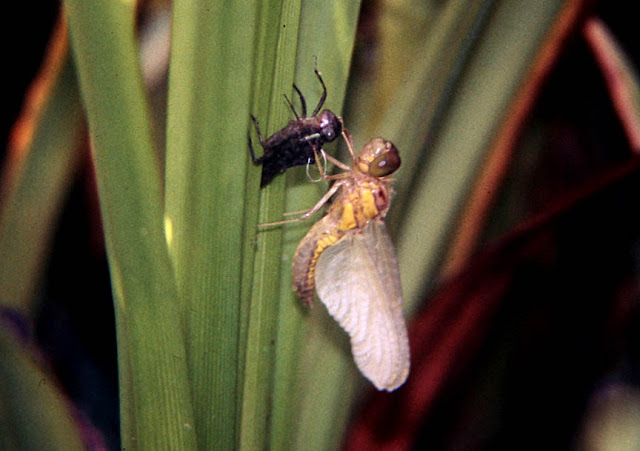Just for fun here are a few species from Europe, all scanned slides hence the quality. No comment re distribution or flight period etc. Captions don't seem to want to go in so, the species are
Azure Damselflys.
Banded Demoiselle.
Banded Demoiselle.
Azure Damselfly.
Yellow Clubtail.
Yellow Clubtail.
White-legged Damselfly.
White-legged Damselfly.
Southern Skimmer.
Southern Emerald.
Small Red Damselfly.
Small red Damselfly.
Scarlet Darter.
Red-veined Darter.
Scarlet Darter.
Scarce Chaser.
Red-veined Darter.
Red-veined Darter.
Red-veined Darter.
Norfolk Hawker.
Large Red Damselfly.
Large Red Damselfly.
Highland Darter.
Golden-ringed Dragonfly.
Golden-ringed Dragonfly.
Goblet-marked Damselfly.
Four-spotted Chaser.
Common Darter.
Brown Hawker.
Broad-bodied Chaser.
Blue-tailed Damselfly.
Blue-tailed Damselfly.
Black-tailed Skimmer.
Black Darter.
Black Darter.
Banded Demoiselle.
Monday, November 23, 2009
Monday, November 16, 2009
Lets get out of the water!
Emerging dragonflies 101
The flying dragonfly is representative of a relatively small part of the insects life. Without getting technical, mainly because I can't, the egg is laid by mummy and daddy (actually mummy, that bit I do know). It hatches and after much messing about ( I could use the word metamorphosis but can't spell it) changes into the bug in the water. After a sometimes lengthyperiod of time, enjoying themselves by eating smaller bugs they get the urge to leave the water.
One fine morning when the temperature is right, the bug (sorry Chris) hoiks itself up a reed stem and gets busy. The back of the bug splits and out climbs a soft, unformed version of the flying insect. Over a couple of hours it uses the suns heat to unpack, pumping bug fluid around its veins and becoming somewhat bigger than its former self. The wings too develop and eventually we have the chap itself. At this stage it is hard to ID the species but over a day or two the coloration comes and the wings stop looking badly varnished and become rather good.
The following sequence of images show this event taking place, sort of. The species is Sympetrum striolatum or Common Darter and I took the photos over a few hours one morning back in England. I presume the insects in North America do exactly the same although perhaps those just over the border do a lot of clapping and cheering about it.
The final image shows another species Aeshna mixta, or Migrant Hawker, in a newly emerged stage. At this age they are very vulnerable and make a tasty snack for those with a taste for them.
These are digital slide copies and so not as good as today's purely digital images are, I'm sure you will get over it.
The flying dragonfly is representative of a relatively small part of the insects life. Without getting technical, mainly because I can't, the egg is laid by mummy and daddy (actually mummy, that bit I do know). It hatches and after much messing about ( I could use the word metamorphosis but can't spell it) changes into the bug in the water. After a sometimes lengthyperiod of time, enjoying themselves by eating smaller bugs they get the urge to leave the water.
One fine morning when the temperature is right, the bug (sorry Chris) hoiks itself up a reed stem and gets busy. The back of the bug splits and out climbs a soft, unformed version of the flying insect. Over a couple of hours it uses the suns heat to unpack, pumping bug fluid around its veins and becoming somewhat bigger than its former self. The wings too develop and eventually we have the chap itself. At this stage it is hard to ID the species but over a day or two the coloration comes and the wings stop looking badly varnished and become rather good.
The following sequence of images show this event taking place, sort of. The species is Sympetrum striolatum or Common Darter and I took the photos over a few hours one morning back in England. I presume the insects in North America do exactly the same although perhaps those just over the border do a lot of clapping and cheering about it.
The final image shows another species Aeshna mixta, or Migrant Hawker, in a newly emerged stage. At this age they are very vulnerable and make a tasty snack for those with a taste for them.
These are digital slide copies and so not as good as today's purely digital images are, I'm sure you will get over it.
Saturday, November 14, 2009
Two from Florida
In 2001 we spent a week sneezing and birding around Florida. Several sites had dragonflies and I was acutally able to buy the through binolculars guide at one place. Photos then were all on slides and some scan better than others.
These were the best (ok, obvious question, how bad were the rest)
Regal Darner top, Halloween Pennant Bottom.
These were the best (ok, obvious question, how bad were the rest)
Regal Darner top, Halloween Pennant Bottom.
Shadow Darner
Shadow Darner Aeshna umbrosa
More dodginess I'm afraid.
Comments always welcome.
Flies July to October.
More dodginess I'm afraid.
Comments always welcome.
Flies July to October.
Subscribe to:
Posts (Atom)
















































